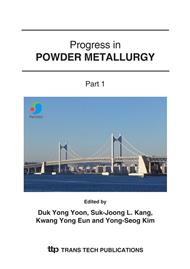[1]
H. Gleiter: Prog. Mater. Sci. Vol. 33 (1989), p.223.
Google Scholar
[2]
R.W. Siegel, in: Mechanical Properties and Deformation Behavior of Materials Having Ultrafine Microstructures, Edited by M. Nastasi, D. M. Parkin, and H. Gleiter, NATO ASI Series, Kluwer, Dordrecht (1993).
DOI: 10.1007/978-94-011-1765-4
Google Scholar
[3]
A.S. Edelstein and R.C. Cammarata: Nanomaterials: Synthesis, Properties and Applications, Edited by IOP Publishing, Bristol (1996).
Google Scholar
[4]
Nanostructured Materials: Processing, Properties and Potential Applications, Edited by C.C. Koch, Noyes Publications/William Andrew Publising, Norwich, NY (2002).
Google Scholar
[5]
Y.H. Kim, A. Inoue and T. Masumoto: Mater. Trans. JIM Vol. 31 (1990), p.747.
Google Scholar
[6]
A.P. Tsai, A. Inoue and T. Masumoto: Metall. Trans. A Vol. 19 (1988), p.1369.
Google Scholar
[7]
A. Inoue, H.M. Kimura, K. Sasamori and T. Masumoto: Mater. Trans. JIM Vol. 36 (1995), p.6.
Google Scholar
[8]
M. Seidel, J. Eckert, H.D. Bauer and L. Schultz, in: Grain Size and Mechanical Properties - Fundamentals and Applications, Edited by M. A. Otooni, R. W. Armstrong, N. J. Grant, and K. Ishizaki, Mater. Res. Soc. Symp. Proc., Materials Research Society, Warrendale, PA (1995).
Google Scholar
[9]
F. Schurack, I. Börner, J. Eckert and L. Schultz: Sci. Forum Vol. 312-314 (1999), p.49.
Google Scholar
[10]
F. Schurack, J. Eckert and L. Schultz: Mater. Sci. Eng. A Vol. 294-296 (2000), p.164.
Google Scholar
[11]
M.H. Lee, J.H. Kim, J.S. Park, J.C. Kim, W.T. Kim and D.H. Kim, Scripta Mater. Vol. 50 (2004), p.1367.
Google Scholar
[12]
S.C. Tjong and Z.Y. Ma, Mater. Sci. Eng. R Vol. 29 (2000), p.49.
Google Scholar
[13]
P. Yu, K.B. Kim, J. Das, F. Baier, W. Xu and J. Eckert: Scipta Mater. Vol. 54 (2006), p.1445.
Google Scholar
[14]
A. Inoue, W. Zhang and T. Zhang, Mater. Trans. Vol. 43 (2002), p. (1952).
Google Scholar
[15]
A. Inoue, T. Zhang, N. Nishiyama, K. Ohba and T. Masumoto: Mater. Trans. JIM Vol. 34 (1993), p.1234.
Google Scholar
[16]
X.H. Lin, W.L. Johnson and W.K. Rhim: Mater. Trans. JIM Vol. 38 (1997), p.473.
Google Scholar
[17]
L.Q. Xing, J. Eckert, W. Löser and L. Schultz: Appl. Phys. Lett. Vol. 73 (1999), p.2110.
Google Scholar
[18]
A. Inoue: Mater. Trans. JIM Vol. 36 (1995), p.866.
Google Scholar
[19]
J. Eckert: Mater. Sci. Eng. A Vol. 226-228 (1997), p.364.
Google Scholar
[20]
S. Scudino, C. Mickel, L. Schultz, J. Eckert, X. Y. Yang and D. J. Sordelet, Appl. Phys. Lett. Vol. 85 (2004), p.4349.
DOI: 10.1063/1.1818734
Google Scholar


